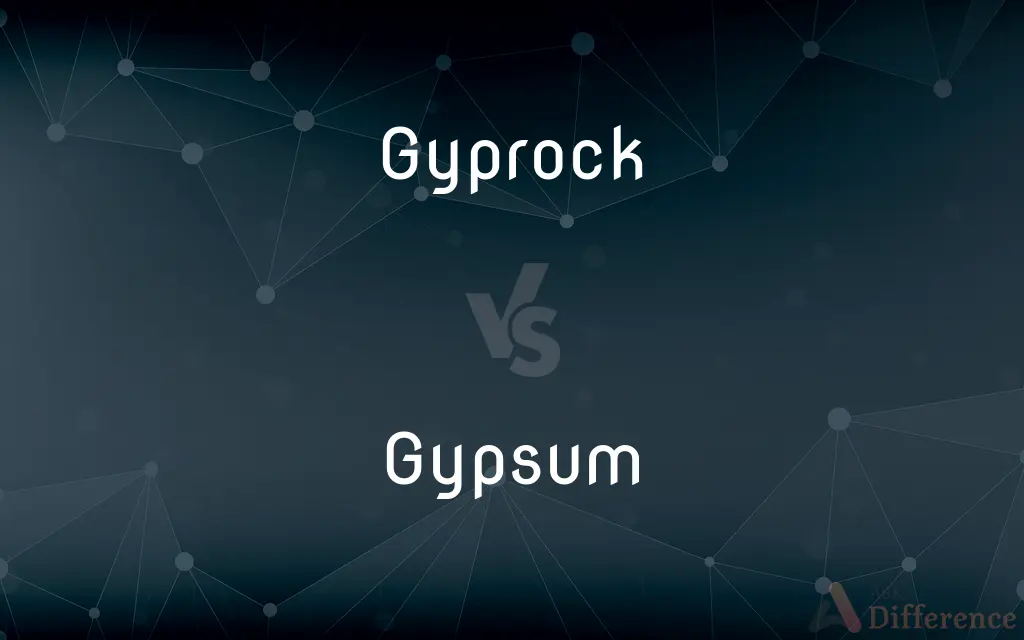Gyprock vs. Gypsum — What's the Difference?
By Tayyaba Rehman & Maham Liaqat — Updated on April 17, 2024
Gyprock, a brand of plasterboard, is specifically designed for wall and ceiling linings, whereas gypsum is a mineral used in the production of plaster and plasterboard.

Difference Between Gyprock and Gypsum
Table of Contents
ADVERTISEMENT
Key Differences
Gyprock is a commercial name for a type of plasterboard or drywall used mainly in building construction for walls and ceilings. On the other hand, gypsum is a naturally occurring mineral composed primarily of calcium sulfate dihydrate, which is a raw material used in the production of various building materials, including plasterboard.
Gyprock boards are known for their fire resistance, sound insulation, and ease of installation. Whereas gypsum itself, as a raw material, possesses qualities that make it ideal for creating a smooth finish and controlling the setting time when mixed with water for plaster.
The manufacturing process of Gyprock involves pressing gypsum between two thick sheets of paper, creating panels that are easy to install and finish. In contrast, gypsum can be processed in different forms, such as powder for use in plaster and as a component in cement.
Gyprock panels are specifically engineered to meet building standards and are available in various thicknesses and sizes to suit different requirements. On the other hand, gypsum in its raw form has a broader range of applications, extending beyond construction to uses in agriculture, art, and medicine.
While Gyprock is typically used in a finished form ready for installation in construction projects, gypsum must be processed and mixed with other materials before it can be used in most of its applications.
ADVERTISEMENT
Comparison Chart
Definition
Brand of plasterboard
Naturally occurring mineral
Composition
Gypsum pressed between paper layers
Calcium sulfate dihydrate
Primary Use
Wall and ceiling linings
Production of plaster and plasterboard
Installation
Installed as panels
Processed into various forms
Applications
Building construction
Construction, agriculture, art, medicine
Compare with Definitions
Gyprock
A plasterboard used for walls and ceilings.
The contractor recommended Gyprock for the interior walls.
Gypsum
Integral in the arts for making sculptures.
Artists prefer gypsum for its fine, moldable texture.
Gyprock
Known for its ease of installation and finishing.
Gyprock is popular in home renovations for its simplicity.
Gypsum
A mineral used in the production of plaster.
Gypsum has been quarried for centuries for use in plaster.
Gyprock
Fire-resistant building material.
Gyprock panels were used in the new building to meet fire safety standards.
Gypsum
Used in agriculture to improve soil composition.
Farmers spread gypsum to enrich the soil with calcium.
Gyprock
Commercial brand of gypsum board.
Gyprock is often specified by name in building plans.
Gypsum
Utilized in medicine as plaster for setting bones.
Gypsum plasters are commonly used for casts in orthopedics.
Gyprock
Often used in soundproofing applications.
For the cinema room, we used Gyprock to minimize noise leakage.
Gypsum
Raw material for making drywall.
Gypsum is processed into a fine powder before being used in drywall production.
Gyprock
Rock rich in gypsum; gypsic soil.
Gypsum
Gypsum is a soft sulfate mineral composed of calcium sulfate dihydrate, with the chemical formula CaSO4·2H2O. It is widely mined and is used as a fertilizer and as the main constituent in many forms of plaster, blackboard/sidewalk chalk, and drywall. A massive fine-grained white or lightly tinted variety of gypsum, called alabaster, has been used for sculpture by many cultures including Ancient Egypt, Mesopotamia, Ancient Rome, the Byzantine Empire, and the Nottingham alabasters of Medieval England.
Gyprock
Drywall.
Gypsum
A widespread colorless, white, or yellowish mineral, CaSO4·2H2O, used in the manufacture of plaster of Paris, various plaster products, and fertilizers.
Gyprock
To drywall.
Gypsum
A mineral consisting of hydrated calcium sulphate. When calcinated, it forms plaster of Paris.
Gypsum
A mineral consisting of the hydrous sulphate of lime (calcium). When calcined, it forms plaster of Paris. Selenite is a transparent, crystalline variety; alabaster, a fine, white, massive variety.
Gypsum
A common white or colorless mineral (hydrated calcium sulphate) used to make cements and plasters (especially plaster of Paris)
Common Curiosities
Is gypsum environmentally friendly?
Gypsum is considered environmentally friendly as it is naturally occurring and non-toxic.
What is gypsum used for?
Gypsum is used to make plaster, plasterboard, and as an additive in cement, among other applications.
How are Gyprock and gypsum related?
Gyprock is a manufactured product that uses gypsum as its primary raw material.
Can Gyprock be used for exterior walls?
Gyprock is generally used for interior walls, though specific exterior-grade products are available.
Can gypsum be recycled?
Yes, gypsum can be recycled from construction and demolition waste.
What is Gyprock?
Gyprock is a brand of plasterboard used primarily for constructing walls and ceilings.
Where is gypsum found?
Gypsum can be mined in large deposits around the world.
What are the benefits of using gypsum in agriculture?
Gypsum helps improve soil structure, reduces soil compaction, and adds essential nutrients like calcium and sulfur.
What makes Gyprock different from regular drywall?
Gyprock often has specific properties like enhanced fire resistance or sound insulation compared to regular drywall.
How is Gyprock installed?
Gyprock panels are fixed to the framing of a building and then finished with joint compounds and paint.
Share Your Discovery

Previous Comparison
Crab vs. Crap
Next Comparison
Ms vs. MissAuthor Spotlight
Written by
Tayyaba RehmanTayyaba Rehman is a distinguished writer, currently serving as a primary contributor to askdifference.com. As a researcher in semantics and etymology, Tayyaba's passion for the complexity of languages and their distinctions has found a perfect home on the platform. Tayyaba delves into the intricacies of language, distinguishing between commonly confused words and phrases, thereby providing clarity for readers worldwide.
Co-written by
Maham Liaqat















































